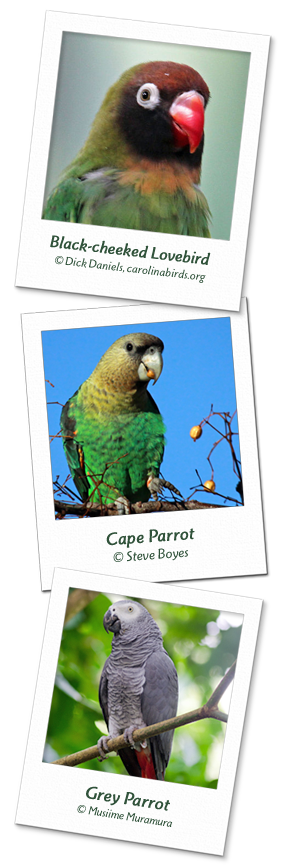Finding Solutions
WPT Project History in Africa
Black-cheeked Lovebird
(Agapornis nigrigenis)From 1995 to 2004 the WPT supported research for the Black-cheeked lovebird, studies which aimed to determine the status and distribution of the species, identify habitat requirements, evaluate threats to the species, and involve local people in the species' recovery.
Learn more at www.parrots.org
Cape Parrot
(Poicephalus robustus)Since 1993 WPT has supported the work of scientists/conservationists in numerous studies to determine the status, distribution, ecology and habitat requirements of the Cape parrot. Local people, including children, have been involved with counting the birds yearly, planting native trees and further developing education and outreach for communities.
Learn more at www.parrots.org
Echo Parakeet
(Psittacula eques)WPT and Durrell Wildlife Conservation Trust joined to save the critically endangered Echo Parakeet in 1990. WPT put resources towards this project, and persuaded other organisations to donate. Management activities to help save the species included nest site protection, monitoring and enhancement, provision of nest boxes, supplementary feeding of at risk individuals, predator and pest control, hand-raising young from failing nests and manipulating clutches to achieve higher reproductive rates.
Learn more at www.parrots.org
Grey Parrot
(Psittacus erithacus)Beginning in 2001, WPT has supported ongoing studies on Grey parrot behaviour and effects of poaching. Since 2008 WPT has been working with NGOs and officials to end the trade in wild caught African parrots, rehabilitate and release confiscated birds, encourage sustainable alternatives to parrot trapping, re-establish wild populations in suitable areas of their former range and raise awareness for the plight of wild Grey parrots.
Learn more at www.parrots.org
Timneh Parrot
(Psittacus timneh)In early 2013 the World Parrot Trust received a report from the Guinea Application of Wildlife Law (GALF) of a group of confiscated birds in Guinea, some of which were Timneh parrots. WPT sent a veterinarian to care for the thirteen Timnehs, funding for the birds' care, and cameras for documentation of their recovery and release. WPT has been funding ongoing projects to further protect and document the species. Nest protection and monitoring have taken place within the Bijagós islands UNESCO Biosphere reserve in Guinea-Bissau.
Learn more at www.parrots.org
Meyer's Parrot
(Poicephalus meyeri)From 2004-08, the WPT supported research to determine this species’ ecology and the factors affecting its status in the wild. Meyer's Parrot are declining in the wild due to habitat destruction, persecution, and heavy trapping for the wild bird trade. Recent surveys have shown wider range than previously thought in some areas of its range to the north and west, and other areas near-disappearance.
Learn more at www.parrots.org
Ruppell's Parrot
(Poicephalus rueppellii)In 1996 the WPT supported researcher Richard Selman from the University of Natal in his studies on Ruppell's Parrot. A study of dietary and nesting requirements in Namibia was done in 1996 and 1997, and various years in the 2000s. Populations may be in decline due to unsustainable levels of trade but more research is required.
Learn more at www.parrots.org
Learn more about other projects currently under way at www.parrots.org





